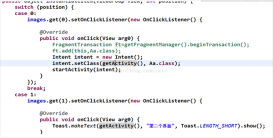本文主要给大家介绍java的InputStream 流的使用。
(1)FileInputstream: 子类,读取数据的通道
使用步骤:
1.获取目标文件:new File()
2.建立通道:new FileInputString()
3.读取数据:read()
4.释放资源:close()
|
1
2
3
4
|
|
1
2
3
4
5
6
7
8
9
10
11
|
public static void main(String[] args) throws IOException {// TODO Auto-generated method stub//分别调用方法查看效果test1();System.out.println("-------------------------------------------");test2();System.out.println("-------------------------------------------");test3();System.out.println("-------------------------------------------");test4();} |
(2)读取数据的三种方式
1.直接读取 (一次只能一个字节)
|
1
2
|
int date = fileInputStream.read(); char date3 = (char)fileInputStream.read(); |
|
1
2
3
4
5
6
7
8
9
10
11
12
13
14
|
//方式一 直接打印public static void test1() throws IOException{//(1)获取目标文件路径File file = new File("C:\\Users\\joke\\Desktop\\Demo1.java");//(2)根据目标文件路径 建立通道: new FileInputStream(file)FileInputStream fileInputStream = new FileInputStream(file);//(3)读取数据 :read();int date = fileInputStream.read();//这里是int类型int date2 = fileInputStream.read();//char date3 = (char)fileInputStream.read(); //以char类型显示System.out.println(date+"\\"+date2+"\\"+date3);//(4)释放资源fileInputStream.close();} |
2.单独使用for循环(效率低)
|
1
2
3
|
for(int i = 0; i < file.length();i++){ System.out.print((char)fileInputStream.read()); } |
|
1
2
3
4
5
6
7
8
9
10
11
12
13
14
|
//方式二 循环遍历public static void test2() throws IOException{//通过时间测试效率long startTime = System.currentTimeMillis();File file = new File("C:\\Users\\joke\\Desktop\\Demo1.java");FileInputStream fileInputStream = new FileInputStream(file);//for循环for(int i = 0; i < file.length();i++){System.out.print((char)fileInputStream.read());}fileInputStream.close();long endTime = System.currentTimeMillis();System.out.println("读取文件所花时间:"+(endTime-startTime));} |
3.Byte[ ] 缓冲区(只能读取指定的字节数不能读取一个完整的文件)
|
1
2
3
|
byte[] bt = new byte[1024]; int count = fileInputStream.read(bt); System.out.println(new String (bt,0,count)); |
|
1
2
3
4
5
6
7
8
9
10
11
12
|
//方式三 创建缓冲区(只能读取制定的大小,不能读取一个完整的文件)public static void test3() throws IOException{File file = new File("C:\\Users\\joke\\Desktop\\Demo1.java");FileInputStream fileInputStream = new FileInputStream(file);//创建缓冲区,加快读取数据,确定要读取的字节大小byte[] bt = new byte[1024];//read() 读取字节int count = fileInputStream.read(bt);System.out.println(count); //显示读取到的字节数System.out.println(new String (bt,0,count));//将字节转为字符串显示fileInputStream.close();} |
4.缓冲区和循环结合。缓冲区一般设置为1024的倍数。理论上设置的缓冲区越大,读取效率越高
|
1
2
3
4
5
|
byte[] bt = new byte[1024]; int count = 0; while((count = fileInputStream.read(bt)) != -1){ System.out.println(new String (bt,0,count)); } |
|
1
2
3
4
5
6
7
8
9
10
11
12
13
14
15
16
17
18
|
//方式四 循环与缓冲区结合(效率高)public static void test4() throws IOException{//通过时间测试效率long startTime = System.currentTimeMillis();File file = new File("C:\\Users\\joke\\Desktop\\Demo1.java");FileInputStream fileInputStream = new FileInputStream(file);//缓冲区一般设置为1024的倍数。理论上设置的缓冲区越大,读取效率越高byte[] bt = new byte[1024];int count = 0;//read返回 -1 时,证明已经遍历完while((count = fileInputStream.read(bt)) != -1){//字符串型显示(从bt中的第0个字节开始遍历count个长度)System.out.println(new String (bt,0,count));}fileInputStream.close();long endTime = System.currentTimeMillis();System.out.println("读取文件所花时间:"+(endTime-startTime));} |
陌陌说:
在以上,对比第二个和第四个方法,会发现方法四的效率是比较高的,所以推荐使用的四个方法
在这里我们是直接抛出异常,除了抛出之外我们还可以使用
try{ }cater{ }finally{ }
的方式来处理异常
以上所述是小编给大家介绍的java IO流 之 输入流 InputString()的使用,希望对大家有所帮助,如果大家有任何疑问请给我留言,小编会及时回复大家的。在此也非常感谢大家对服务器之家网站的支持!
原文链接:http://www.cnblogs.com/bigerf/archive/2016/12/06/6136557.html












